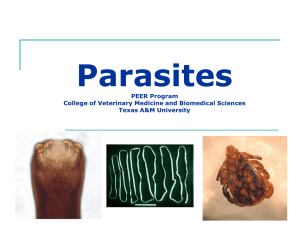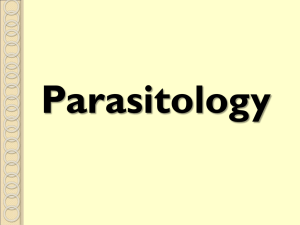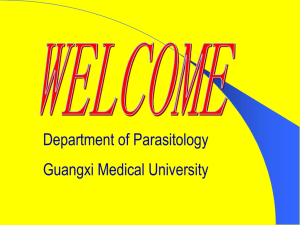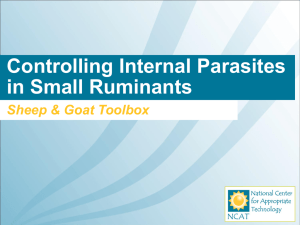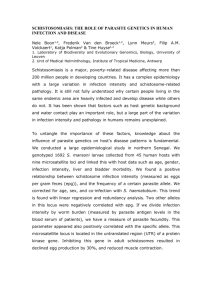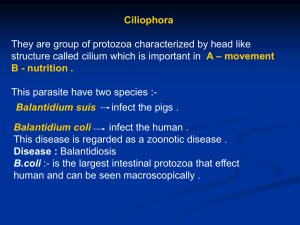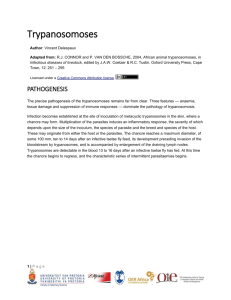Phylogenetic host specificity and understanding
advertisement
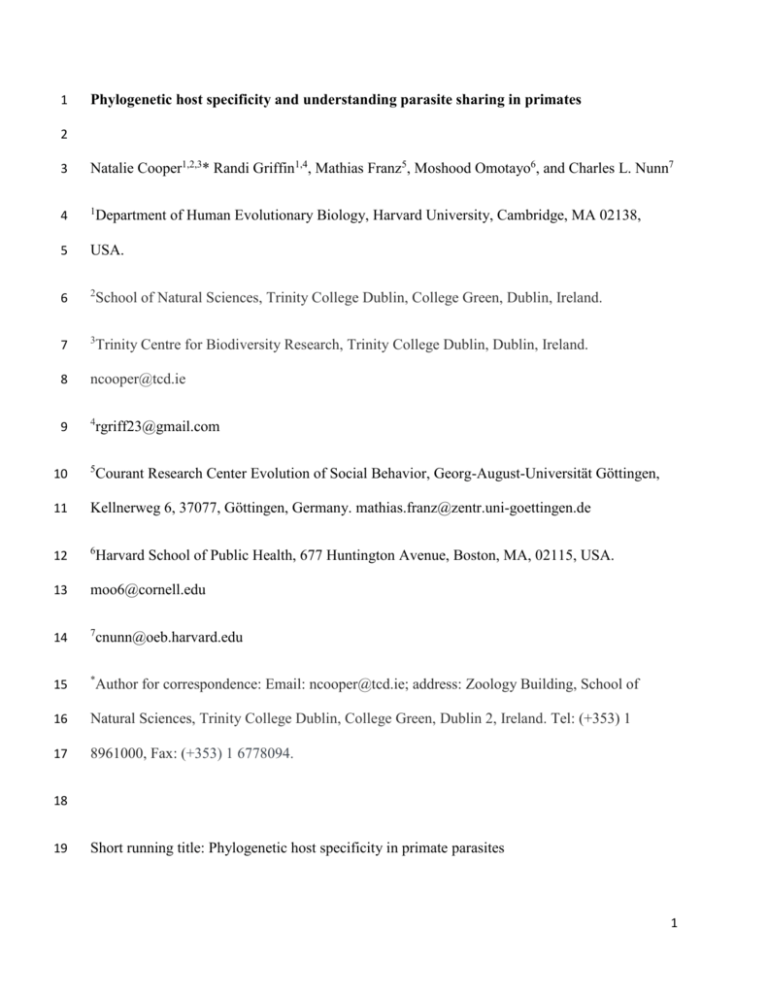
1 Phylogenetic host specificity and understanding parasite sharing in primates 2 3 Natalie Cooper1,2,3* Randi Griffin1,4, Mathias Franz5, Moshood Omotayo6, and Charles L. Nunn7 4 1 5 USA. 6 2 School of Natural Sciences, Trinity College Dublin, College Green, Dublin, Ireland. 7 3 Trinity Centre for Biodiversity Research, Trinity College Dublin, Dublin, Ireland. 8 ncooper@tcd.ie 9 4 rgriff23@gmail.com 10 5 Courant Research Center Evolution of Social Behavior, Georg-August-Universität Göttingen, 11 Kellnerweg 6, 37077, Göttingen, Germany. mathias.franz@zentr.uni-goettingen.de 12 6 13 moo6@cornell.edu 14 7 15 * 16 Natural Sciences, Trinity College Dublin, College Green, Dublin 2, Ireland. Tel: (+353) 1 17 8961000, Fax: (+353) 1 6778094. Department of Human Evolutionary Biology, Harvard University, Cambridge, MA 02138, Harvard School of Public Health, 677 Huntington Avenue, Boston, MA, 02115, USA. cnunn@oeb.harvard.edu Author for correspondence: Email: ncooper@tcd.ie; address: Zoology Building, School of 18 19 Short running title: Phylogenetic host specificity in primate parasites 1 20 Keywords (10 max): specialist; generalist; protozoa; helminth; virus; vector; intermediate host; 21 phylogenetic comparative methods. 22 23 Type of article: Letter 24 Number of words in the abstract: 144 25 Number of words in the main text (excluding abstract, acknowledgements, references, table and 26 figure legends): 4997 27 Number of references: 49 28 Number of figures and tables: 5 (3 figures and 2 tables) 29 Statement of authorship: NC designed the study, performed the analyses, and wrote and revised 30 the manuscript. RG contributed to the study design and performed analyses. MF contributed to 31 the study design. MO collected the geoferencing data. CLN designed the study and revised the 32 manuscript. 33 2 34 Abstract 35 Understanding how parasites are transmitted to new species is of great importance for 36 human health, agriculture and conservation. However, it is still unclear why some parasites are 37 shared by many species, while others have only one host. Using a new measure of “phylogenetic 38 host specificity”, we find that most primate parasites with more than one host are phylogenetic 39 generalists, infecting less closely related primates than expected. Evolutionary models suggest 40 that phylogenetic host generalism is driven by mixture of host-parasite cospeciation and lower 41 rates of parasite extinction. We also show that phylogenetic relatedness is important in most 42 analyses but fails to fully explain patterns of parasite sharing among primates. Host ecology and 43 geographical distribution emerged as key additional factors that influence contacts among hosts 44 to facilitate sharing. Greater understanding of these factors is therefore crucial to improve our 45 ability to predict future infectious disease risks. 46 3 47 Introduction 48 Emerging infectious diseases (EIDs) present a major challenge to the health of humans 49 and our domesticated animals and crops (Morens et al. 2004; Woolhouse et al. 2005). EIDs also 50 affect wild animals and plants, and can be major drivers of wildlife population declines (e.g., 51 amphibians and Tasmanian devils; McCallum & Jones 2006; Kilpatrick et al. 2010). The source 52 of EIDs is often other species; for example, many recent human pandemics originated in wildlife, 53 including HIV and SARS, and parasite introduction via introduced species is a major driver 54 of plant EID emergence (Anderson et al. 2004; Wolfe et al. 2005; Wolfe et al. 2007; Jones et al. 55 2008). If we understand the factors that increase the likelihood of parasites switching from one 56 host species to another, we can identify problematic parasites before they are transmitted to new 57 hosts. This would be advantageous for public health reasons, and for agriculture and the 58 conservation of biodiversity. 59 The most reliable way to determine whether a parasite – here defined as any infectious 60 organism – can switch from one species to another is to experimentally infect the new host in the 61 laboratory. However, this is expensive, time consuming and raises ethical concerns for some host 62 taxa. Another solution is to take a comparative approach that considers how parasites are shared 63 among host species in nature. Patterns of present-day parasite sharing will reflect (among other 64 things) historical transfers of parasites from one host to another. Thus, we can use the degree of 65 parasite sharing among hosts to make inferences about the host and parasite characteristics that 66 promote host switching. To do this, we must first consider the steps involved in a host shift. 67 Initially the new host must make contact with the parasite, the likelihood of which will depend 68 on factors that include: whether the host and parasite have overlapping geographic ranges; the 69 parasite’s transmission mode (e.g., sexually transmitted diseases are less likely to be encountered 4 70 by new hosts than environmentally transmitted diseases); the parasite’s abundance in the original 71 host; and similarities in the ecology and behavior of the hosts. Once a new host is exposed, the 72 probability that the parasite can replicate and spread to other individuals depends on the host’s 73 immune defenses and the parasite’s ability to circumvent these defenses (Woolhouse et al. 2005; 74 Parrish et al. 2008). 75 Previous authors have suggested that each stage of the host-shifting process is more 76 likely if the original host and the new host are closely-related, because closely-related species are 77 likely to be similar in ecological, behavioral, physiological and distributional traits that increase 78 the likelihood of exposure to a parasite and the ability of the parasite to circumvent the host’s 79 immune defenses (Woolhouse et al. 2005; Engelstädter & Hurst 2006; Wolfe et al. 2007; Davies 80 & Pedersen 2008). Indeed, in a range of host-parasite systems, parasites are more commonly 81 shared among close relatives than among more distant relatives (e.g., Davies & Pedersen 2008; 82 Krasnov et al. 2010; Poulin 2010; Streicker et al. 2010; Longdon et al. 2011). However, 83 processes other than host switching also influence patterns of parasite sharing (summarized in 84 Fig. S1; see Appendix S1 in Supporting Information). Close relatives also inherit parasites from 85 their last common ancestor, and thus should share more parasites through common descent (this 86 is referred to as cospeciation; Engelstädter & Hurst 2006). In addition, parasites may be missing 87 from some species simply because the host has been studied insufficiently to detect the parasite, 88 or because the parasite has gone extinct. 89 Here, we use phylogenetic comparative methods to identify factors that influence parasite 90 sharing among primate hosts. We use primates because they are well-studied and also our closest 91 relatives, allowing us to make inferences about parasite sharing among primates and humans. 92 Using a measure of “phylogenetic host specificity” (or “phylospecificity”; Poulin et al. 2011), 5 93 we first investigate whether parasites infect more closely-related hosts than expected by chance. 94 Our measure differs from standard measures of host specificity because it takes into account the 95 relatedness of the hosts, rather than relying on taxonomic or other categories (e.g., Pedersen et al. 96 2005). With this measure, a parasite that infects distantly-related hosts is a phylogenetic host 97 generalist, whereas a parasite that infects closely-related hosts is a phylogenetic host specialist. 98 We predict that viruses will be phylogenetic host generalists because the fast rates of viral 99 evolution should allow them to easily adapt to new hosts (Woolhouse & Gowtage-Sequeria 100 2005; Parrish et al. 2008; Elena & Froissart 2010). Conversely, we predict that helminths will be 101 phylogenetic host specialists, due to their often complex lifecycles that may constrain their 102 ability to adapt to new hosts (Woolhouse et al. 2005; Parrish et al. 2008). We also use 103 evolutionary models to investigate whether patterns of sharing are driven by host shifts, host- 104 parasite cospeciation, parasite extinction, or biases in sampling effort (summarized in Fig. S1). 105 Next, we investigate patterns of parasite sharing among primates in relation to primate 106 phylogeny, ecology and geography, and parasite phylogenetic host specificity. We predict that 107 parasite sharing will be highest among closely-related, ecologically similar primates that live in 108 close proximity, as these factors should favor parasite transmission. We also expect that the 109 relationship between parasite sharing and host phylogeny will be stronger in phylogenetically 110 host specialized parasites. Finally, we use phylogenetic models to investigate levels of parasite 111 sharing among primates and humans. 112 6 113 Materials and Methods 114 Host-parasite data 115 We obtained 2867 host-parasite combinations, representing 128 primate species and 437 116 parasite species (60 viruses, 247 helminths, 91 protozoa, 35 bacteria and four fungi), from the 117 Global Mammal Parasite Database (GMPD, accessed 25th July 2011; Nunn & Altizer 2005). We 118 took our list of endemic human parasites from Taylor et al. (2001). 119 120 121 Primate data For each species, we collated data on adult body mass (g) and social group size from 122 various sources (de Magalhaes & Costa 2009; Jones et al. 2009, Nowak 1999 plus references in 123 Appendix S2). We also defined each species as terrestrial (> 90% of time on ground), semi- 124 terrestrial (< 90% but > 50% of time on ground), semi-arboreal (< 90% but > 50% of time in 125 trees) or arboreal (> 90% of time in trees). 126 We downloaded geographic range maps from the IUCN (2010) and used these to 127 estimate the geographic range size of each species (km2). For each pair of primates we then 128 determined their geographic range overlap (km2) and the geodesic distance between their 129 geographic range centroids (km). We obtained mean annual temperature (0.1°C) and 130 precipitation (mm) data from WorldClim (Hijmans et al. 2005) and extracted mean temperature 131 and precipitation values for each primate’s geographic range. We used the R packages maptools 132 (Lewin-Koh & Bivand 2011), PBSmapping (Schnute et al. 2010), raster (Hijmans & van Etten 133 2011), rgdal (Keitt et al. 2011) and sp (Pebesma & Bivand 2005) for all geographic data 134 manipulation. 7 135 As a measure of sampling effort we collected citation counts for each primate species, 136 i.e., the number of references retrieved from the ISI Web of Knowledge (http://wokinfo.com/; 137 accessed 5th July 2012), where the Latin binomial of the species appeared in either the title or 138 topic fields, and either “parasite”, “disease” or “pathogen” also appeared in the topic field. 139 Where the species binomial had changed between 1993 and 2005 (Wilson & Reeder 1993, 2005) 140 we summed the number of citations for the species names from both taxonomies. We used the 141 dated consensus phylogeny from 10kTrees version 3 (Arnold et al. 2010) and the taxonomy of 142 Wilson & Reeder (2005) for all analyses. 143 144 145 Parasite data We defined each parasite’s geographic range as the union of the geographic ranges of its 146 hosts (GR1). However, it is unlikely that a parasite will be found across the whole geographic 147 range of a host, especially where hosts have large ranges. Therefore we derived a second parasite 148 geographic range (GR2). GR2 was equal to the area encompassed by the minimum convex 149 polygon created using the host-parasite latitude and longitude locality records for a given 150 parasite, plus a five degree buffer. To estimate GR2, we obtained latitude and longitude 151 coordinates for each host-parasite combination from the GMPD. We excluded localities that we 152 were unable to unambiguously georeference, and localities with an extent greater than 153 10,000km2. We then extracted geographic ranges for our parasites using the R packages cited 154 above plus rgeos (Bivand & Rundel 2011) and wild1 (Sargeant 2011). Parasite geographic 155 ranges are probably highly dynamic and vary seasonally; thus, we lack information on which of 156 these ranges best represents the true geographic range of the parasite. Therefore, we performed 8 157 analyses using both GR1 and GR2. We report only results using GR2; however, our GR1 results 158 are qualitatively similar. 159 160 161 Sampling biases Host-parasite data are sensitive to sampling effort: hosts which have been thoroughly 162 sampled for parasites may appear to have more parasites than those which have been less well- 163 sampled (Gregory et al. 1996). To deal with this issue, we focused on well-sampled primates, 164 defined as species with at least 10 different parasites and evidence for saturation in their parasite 165 accumulation curves (Fig. S2). This left 35 primate species, 2144 host-parasite combinations, 166 and 346 parasite species (52 viruses, 180 helminths, 78 protozoa, 33 bacteria and three fungi). 167 We report results using the 35 well-sampled primate species; however our results were 168 qualitatively similar when we used all primate species. All data are available in Appendix S3. 169 170 ANALYSES 171 Phylogenetic host specificity 172 We first investigated whether primate parasites infect more closely-related hosts than 173 expected by chance by using the net relatedness index (NRI) to investigate the “phylogenetic 174 host specificity” (or “phylospecificity”; Poulin et al. 2011) of each parasite (Webb et al. 2002). 175 NRI is based on the mean phylogenetic distance (MPD) between all possible pairs of hosts 176 infected by a parasite (MPDobs), where phylogenetic distance is defined as the sum of all 177 intervening branch lengths between two hosts. To allow comparisons among multiple parasites, 178 we standardized these MPD values by (i) subtracting the mean MPD expected for n hosts drawn 179 at random from the host phylogeny across 999 iterations (MPDn) and then (ii) dividing by the 9 180 standard deviation of the MPD from these 999 randomly drawn n hosts (s(MPDn)). Finally we 181 multiplied these values by -1 so that positive values of NRI reflect phylogenetic host 182 specialization. Thus, NRI is calculated as follows: 183 NRI = -1*((MPDobs - MPDn) / s(MPDn)) (1) 184 To test for statistical significance in phylogenetic host specificity, we compared MPDobs values 185 with those from the 999 randomly generated MPD values. A parasite was considered 186 significantly phylogenetically host specific if less than 5% of these random MPD values were 187 larger than MPDobs (p < 0.05). 188 We estimated NRI values for each parasite that infected at least two of our 35 primate 189 hosts (N = 141) using the R package picante (Kembel et al. 2010). We used χ2 tests to determine 190 whether different groups of parasites (virus, protozoa or helminth), or parasites transmitted by 191 vectors or intermediate hosts rather than by more direct means, had significantly different 192 proportions of phylogenetic host specialist parasites. We also ran simulations to investigate 193 whether sampling effort affected our power to detect significant phylogenetic host specificity 194 (Appendix S4). 195 196 197 Evolutionary models Patterns of phylogenetic host specificity are the result of multiple processes including 198 host shifts, parasite extinctions and host-parasite cospeciation (summarized in Fig. S1). To better 199 understand these mechanisms we used maximum likelihood methods to compare three 200 evolutionary models: (i) host-shifts and parasite extinctions occur at different rates, (ii) host- 201 shifts and parasite extinctions occur at equal rates, and (iii) only parasite extinctions occur. We 202 computed the maximum likelihood for each model using the MultiState option in BayesTraits 10 203 (Pagel et al. 2004). This fits a continuous-time Markov model to discrete character data 204 distributed on the tips of a phylogenetic tree by traversing the phylogeny and estimating rate 205 parameters associated with transitions among character states (Pagel et al. 2004). We then used 206 AIC to select the best model for each parasite, defining models with greater than 2 units 207 difference in AIC as different. We also compared estimated rates of host shifts (host gain) and 208 parasite extinction (host loss) taken from model (i) to determine which process occurred at a 209 higher rate. 210 211 212 213 214 215 216 Parasite sharing among primates We estimated the similarity of parasite communities among pairs of primate hosts using either Jaccard’s index (Jaccard 1922): Parasite similarity = a/(a+b+c) (2) or a modified version of Jaccard’s index, calculated as follows: Parasite similarity = ((a+e)/γ)/((a+b+c+e)/γ) (3) 217 where a is the number of parasites shared by host species B and C, b is the number of parasites 218 unique to species B, c is the number of parasites unique to species C, and e is the number of 219 parasites present in the shared parasite species pool (γ) but missing from species B and C. We 220 defined the shared parasite species pool, γ, as all the parasites with geographic ranges that 221 overlap with the geographic ranges of both species B and C. We divide by γ so that parasite 222 similarity values range from 0 to 1, where 0 indicates that species B and C have no shared 223 parasites nor any shared absences of parasites, to 1 where species B and C share all their 224 parasites and/or absences of parasites. We include this modified version because Jaccard’s index 225 does not include information on shared absences of species (Anderson et al. 2011), and in terms 11 226 of parasite transmission likelihoods, whether two species both lack a parasite may be informative 227 (e.g., it may indicate that the parasite lacks the ability to circumvent the immune system of both 228 species). Because parasite similarity values are bounded between 0 and 1 and thus produce non- 229 normal error distributions, we logit transformed our similarity indices, after first adding the 230 minimum non-zero value of parasite similarity to each value (because zeros cannot be log 231 transformed; Warton & Hui 2011). Note that where we report predicted values and intercepts we 232 subtract this value from our estimates. 233 After calculating parasite similarity for all primate pairs, we fit linear models of each 234 similarity index against the time since the species’ most recent common ancestor, i.e., divergence 235 time (Davies & Pedersen 2008). Previous studies have shown that divergence time does not fully 236 explain variation in parasite sharing (e.g., Davies & Pedersen 2008), which could be the result of 237 differences in the ecology or distribution of host pairs. We therefore fit linear models of parasite 238 similarity against divergence time with all possible combinations of the following variables: the 239 difference between each species pair in adult body mass, social group size, terrestriality (as a 240 ranked ordinal variable), mean annual temperature and precipitation, the geographic range 241 overlap of each pair of species and the distance between their geographic range centroids. All 242 predictor variables except terrestriality were natural-log transformed prior to analysis. We then 243 used model averaging with the R package MuMIn (Barton 2011) to summarize the 95% 244 confidence set of models for explaining variation in parasite similarity with divergence time as a 245 fixed variable in all models. We repeated all analyses using subsets of the data restricted to 246 phylogenetic host specialist or generalist parasites, viruses, protozoa and helminths separately. 247 To determine whether sampling effort could bias our results and account for the 248 relationship between parasite similarity and divergence time, we fit models of parasite similarity 12 249 against the sum of citation counts from species B and C, and the difference in citation counts 250 from species B and C. Both predictors were natural-log transformed prior to the analysis. We 251 also note that because each species appears multiple times in our pairwise measures of parasite 252 similarity, our models contain pseudoreplication. However, each pair of primates produces an 253 independent value of parasite similarity and, since we are using these values in the models rather 254 than species values, we feel this is not a major issue. A more important issue is pseudoreplication 255 in divergence times, i.e., each New World monkey versus Old World monkey comparison has 256 the same divergence time, leading to many points with the same value. To determine whether 257 this influenced our results we repeated the analyses 1000 times, randomly selecting only one 258 species pair for each divergence time on each iteration, fitting the models and then averaging the 259 results across all 1000 iterations. Our results are qualitatively similar (Table S1). 260 261 Human-primate parasite sharing predictions 262 We used the parasite sharing models described above to predict levels of parasite sharing 263 among primates and humans. We used only human parasites which also occurred in our primate 264 dataset so we could classify parasites as phylogenetic host specialists or generalists. We assumed 265 that humans could potentially contract any parasite due to our cosmopolitan distribution. 266 267 Results 268 Phylogenetic host specificity 269 58 of 141 parasites were identified as phylogenetic host specialists, i.e., they infect more 270 closely-related primate species than expected by chance (Table 1; Fig. 1; Appendix S3). As 271 predicted, viruses had lower phylogenetic host specificity than protozoa or helminths (χ2 = 9.745, 13 272 df = 2, p = 0.008; Table 1), but there were no significant differences among transmission modes 273 (χ2 = 1.554, df = 1, p = 0.213; Table 1). When parasites with a single host were included as 274 specialists, helminths had much higher phylogenetic host specificity than protozoa or viruses (χ2 275 = 11.57, df = 2, p = 0.003; Table 1), but differences among transmission modes remained non- 276 significant (χ2 = 0.004, df = 1, p = 0.9496; Table 1). Simulations revealed that our method had 277 very high power to detect significant phylogenetic host specificity even under heterogeneous 278 host sampling (Appendix S4). Our results were qualitatively similar when we used only well- 279 sampled parasites (i.e., those with > 4 hosts from our subset of 35 well-sampled primates). 280 281 282 Evolutionary models Evolutionary model (i), where hosts were gained and lost at different rates, was the best 283 fitting model for 89 of our 141 parasites, suggesting that their transmission history included a 284 mixture of host shifts, host-parasite cospeciation and parasite extinction (Appendix S3). The 285 remaining 52 parasites showed support for more than one model, although model (i) was always 286 one of the equally supported models. Rates of host gain in these models were much lower than 287 rates of host loss, suggesting that the patterns are driven mainly by host-parasite cospeciation and 288 parasite extinction, rather than extensive host switching (Appendix S3). These results did not 289 differ when phylogenetic host generalist and specialist parasites were considered separately. We 290 also found no significant differences in the host gain to host loss rate ratio between phylogenetic 291 host generalist and specialist parasites (ANOVA: F1,140 = 0.133, p = 0.716), or among parasite 292 types (ANOVA: F4,136 = 1.868, p = 0.119). 293 294 Parasite sharing among primates 14 295 As predicted, we found a significant negative relationship between divergence time and 296 parasite similarity (r2 = 0.331), and this relationship held across all transmission modes and 297 parasite types (Fig. 2; Fig. S3; Table S2) using either of the Jaccard’s indices (Table S5). This 298 relationship is strongest in phylogenetic host specialist parasites (r2 = 0.411; phylogenetic host 299 generalists: r2 = 0.161), with the greatest scatter about the regression line in viruses (r2 = 0.116), 300 but with little difference between transmission modes (Table S2 and Table S5). 301 The estimated intercept of the relationship between divergence time and parasite 302 similarity for all parasites was 0.793±0.022, whereas theoretically it should be one (i.e., when 303 divergence time is zero parasite communities should be identical, although this will be true only 304 when all parasites in a host are recorded without sampling error). The lower than expected 305 intercept suggests that parasite sharing among primates is not simply the result of phylogenetic 306 relationships. When phylogenetic host specialist parasites alone were considered, the intercept 307 was 0.903±0.018, which is much closer to one, versus 0.449±0.033 in phylogenetic host 308 generalist parasites suggesting that phylogenetic relatedness is more important for parasite 309 sharing in phylogenetic host specialists than in phylogenetic host generalists. 310 Statistical models including ecology and geography explained substantially more of the 311 variation in parasite sharing than models including only divergence time (“best” model, all 312 parasites, r2 = 0.613; Table 2; Table S3 and Table S6). Other than divergence time, the most 313 important predictors in our models were the distance between host geographic range centroids, 314 the body mass difference between hosts, and the difference in mean annual temperature across 315 the species’ ranges. As predicted, parasite sharing increased as differences decreased, indicating 316 that greater geographic and ecological similarity increases parasite similarity (Table 2; Table 317 S3). The relative importance of these factors varied with subsets of the data; only the distance 15 318 between host geographic range centroids was consistently found in all of our 95% confidence 319 sets of models. Thus, greater distances resulted in lower parasite similarity, consistent with 320 opportunity for contact and/or habitat similarity as predictors of parasite sharing. 321 Although we found significant relationships among parasite similarity and host sampling 322 effort, these associations were weak (mean r2 < 0.05), suggesting that our results are not an 323 artifact of differences in sampling effort (Table S4). 324 325 326 Human-primate parasite sharing predictions As predicted by the parasite sharing models, we share most parasites with our closest 327 relatives, chimpanzees and gorillas (Fig. 3). However, overall parasite sharing did not decrease 328 predictably with phylogenetic distance: on average, humans share more parasites with Old World 329 monkeys and lemurs than with orangutans. This appears to be because humans share far fewer 330 phylogenetic host specialist parasites with chimpanzees, gorillas and orangutans than predicted 331 by our models (Fig. 3). When considering phylogenetic host generalists, however, parasite 332 sharing among humans and primates decreased more consistently with phylogenetic distance 333 (Fig. 3). 334 335 Discussion 336 Over 60% of human emerging infectious diseases are shared with animals (Jones et al. 337 2008). Thus, it is vitally important to understand the drivers of parasite sharing among species 338 so we can predict which parasites may emerge in humans in the future. Previous authors found 339 that close relatives should share more parasites than distant relatives (e.g., Davies & Pedersen 340 2008; Krasnov et al. 2010; Longdon et al. 2011). We also show that closely related primates 16 341 share more parasites than more distantly related primates. Importantly, however, phylogenetic 342 distance did not fully explain variation in parasite sharing; ecological and distributional 343 differences among primates were also relevant predictors, particularly the distance between the 344 species’ geographic ranges. Davies and Pedersen (2008) also found that geographic range 345 overlap was important for parasite sharing in primates, and Krasnov et al. (2010) found that 346 environmental differences were important in ectoparasite sharing among rodents, particularly for 347 ectoparasites that sometimes live independently of their hosts. Conversely, Longdon et al. (2011) 348 found that phylogenetic distances among hosts explained almost all variation in the ability of 349 viruses to infect new Drosophila species. However, they avoided any effects of host ecology and 350 distribution by artificially infecting the hosts. 351 Taken together, these results suggest that host ecological and distributional differences 352 are important through their affects on the rate and intensity of initial host-parasite contacts, while 353 phylogeny is important for parasite sharing only after host-parasite contact has occurred. Other 354 factors are also important for understanding parasite sharing. Using a measure of phylogenetic 355 host specificity, for example, we found more variance in parasite sharing was explained by 356 phylogeny for host specialist parasites. 357 Most of our parasites were phylogenetic host generalists, infecting more distantly related 358 primates than expected. Evolutionary models suggest these patterns are driven primarily by 359 parasite extinction and host-parasite coevolution rather than host switching (although our method 360 may not detect recent host switching among many close relatives, e.g., SIV; Charleston & 361 Robertson 2002). This was true for phylogenetic host generalist and specialist parasites, although 362 we expected to see higher rates of host switching in phylogenetic host generalists. These results 363 suggest that phylogenetic host generalists infect many hosts by resisting extinction (rather than 17 364 by regularly switching hosts). Parasite extinctions could occur through the evolution of host 365 immune defenses, changes in host ecology or distribution that make the host unsuitable (e.g., 366 dispersal to an area without an appropriate vector), competitive exclusion by other parasites, or 367 simply by chance (e.g., “missing the boat” at speciation; Krasnov et al. 2010). Phylogenetic host 368 generalists may avoid extinction by quickly evolving adaptations to circumvent such host 369 changes. 370 Most viruses in our dataset are phylogenetic host generalists. Interestingly, Longdon et 371 al. (2011) found the opposite result in Drosophila sigma viruses, although this may reflect that 372 the hosts were infected artificially. Contrary to expectations, evolutionary models did not show 373 that viruses had higher rates of host switching than other groups of parasites. This suggests that 374 viruses are particularly good at resisting extinction, perhaps owing to higher rates of evolution 375 (Woolhouse & Gowtage-Sequeria 2005; Woolhouse et al. 2005; Parrish et al. 2008; Elena & 376 Froissart 2010). Bacteria were also predominantly phylogenetic host generalists, although we 377 have little data on these parasites (Table 1). Protozoa and helminths, in contrast, have fairly equal 378 numbers of phylogenetic host specialists and generalists. However, this changes if we consider 379 parasites with just one host. Around 50% of viruses, 70% of bacteria, 40% of protozoa and 70% 380 of helminths in our dataset infect only a single primate species, suggesting that we are 381 underestimating phylogenetic host specificity. One explanation for this pattern involves 382 constraints imposed by the parasite’s lifecycle. For example, helminths often have complex 383 lifecycles, which may reduce their ability to adapt to new hosts because they must retain 384 adaptations to their intermediate hosts (Woolhouse et al. 2005; Parrish et al. 2008). In addition, 385 vector borne or intermediate host parasites are also constrained by availability of sufficient 386 competent vectors or susceptible intermediate hosts, even in areas where susceptible hosts are 18 387 abundant (Randolph & Rogers 2010; Kilpatrick 2011). However, we failed to find any 388 differences in phylogenetic host specificity in relation to transmission mode. Parasites may also 389 appear to infect only one host due to low sampling effort (see below). 390 Our parasite sharing models predicted that humans should share most parasites with our 391 closest primate relatives. However, parasite sharing did not decrease with phylogenetic distance 392 as strongly as expected; humans share more host-specific parasites with Old World monkeys and 393 lemurs than with our closer relative the orangutan. This departure from expectations may reflect 394 the greater research effort aimed at documenting parasites in Old World monkeys (see Fig. S2), 395 especially as many macaque species are used in medical research, and because of greater contact 396 between humans and these lineages of primates. For example, humans are likely to have more 397 contact with Old World monkeys than orangutans because orangutans are rare and primarily 398 arboreal, whereas Old World monkey species are more terrestrial and are often commensal with 399 humans (Smuts et al. 1987). In addition, many human diseases appear to originate from human- 400 wildlife contact during bushmeat hunting or butchering, including Old World monkeys (Wolfe et 401 al. 2005; Betsem et al. 2011). Hence, these findings also suggest that the rate and intensity of 402 parasite contacts is a better predictor of parasite sharing among species than phylogeny alone, 403 which may explain why more parasites of humans are shared with rodents and domestic animals 404 than with wild primates (Woolhouse & Gowtage-Sequeria 2005; Engelstädter & Hurst 2006; 405 Wolfe et al. 2007; Parrish et al. 2008). We omitted ecological differences in analyses involving 406 humans because human ecological attributes are difficult to quantify. It would be useful to 407 formalize ecological overlap between humans and other mammals more formally in future 408 extensions of this research. 19 409 Sampling effort is a major issue in comparative analyses of parasites because poorly- 410 studied hosts will appear to have fewer parasites than well-known hosts (Gregory et al. 1996). 411 We dealt with this issue by focusing on the 35 best-studied primates (out of 376 species in the 412 Order Primates; Wilson & Reeder 2005) and find that our analyses still had high power to detect 413 significant phylogenetic host specificity even under heterogeneous parasite sampling. However, 414 we also find that even in these well-studied primates, more effort is needed to sample the full 415 complement of parasites found in most primates, as indicated by only slight saturation in the 416 parasite accumulation curves (Fig. S2). In addition, 205 parasites are found only in one primate 417 species. In some cases the lack of saturation reflects a truly specialized parasite; in others it 418 likely reflects under-sampling of the parasite. This under-sampling is also uneven across parasite 419 groups: bacterial parasites are rarely reported, possibly due to lower severity of bacterial diseases 420 compared to viral diseases (e.g., Ebola). Given the past and future implications of emerging 421 parasites contracted from human-wildlife contacts, further research into wildlife parasites is 422 crucial to fill these research gaps. 423 Several other methodological issues deserve mention. First, many parasite “species” 424 consist of multiple cryptic species that infect different hosts. Treating these cryptic species as 425 one species could artificially inflate the phylogenetic host specificity of the parasite; however, if 426 a cryptic species complex is phylogenetically host specific, it is likely that its constituent species 427 will be, too. In addition, species definitions differ across types of parasite, which make it difficult 428 to compare phylogenetic host specificity across parasite types. Second, our measure of 429 phylogenetic host specificity only captures one aspect of host specificity in parasites. Poulin et 430 al. (2011) discuss other important factors, including structural (i.e., how the parasite prevalence 431 and abundance vary among hosts) and geographical (i.e., how host use varies geographically) 20 432 specificity. Third, the mechanisms leading to a pair of hosts sharing two closely related parasites 433 or two distantly related parasites probably differ; however our methods do not distinguish 434 between these scenarios. If parasite relatedness was considered, we would expect parasite 435 sharing of closely-related parasites to be more strongly governed by host phylogeny. We did not 436 consider parasite relatedness due to a lack of suitable parasite phylogenies; however, this should 437 be considered in the future as more comprehensive parasite phylogenies are published (Poulin et 438 al. 2011). 439 In conclusion, understanding the drivers of parasite sharing among species is vital to 440 understanding which parasites will be more likely to emerge in humans, domesticated animals, 441 crops, or endangered wildlife. Our results confirm that more closely related hosts are more likely 442 to share parasites, but also highlight the importance of host ecology and geographical 443 distribution, and of the phylogenetic host specificity of the parasites involved. We also highlight 444 major gaps in our knowledge of wildlife parasites. Greater understanding of these gaps is 445 essential to improve our ability to predict future infectious disease risks. 446 447 Acknowledgements 448 We thank the Nunn lab and three anonymous referees for helpful comments. Funding was 449 provided by Harvard University and the NSF (BCS-0923791). 450 451 21 452 References 453 1. 454 Anderson M.J., Crist T.O., Chase J.M., Vellend M., Inouye B.D., Freestone A.L., et al. (2011). 455 Navigating the multiple meanings of diversity: a roadmap for the practicing ecologist. 456 Ecol Lett, 14, 19-28. 457 2. 458 Anderson P.K., Cunningham A.A., Patel N.G., Morales F.J., Epstein P.R. & Daszak P. (2004). 459 Emerging infectious diseases of plants: pathogen pollution, climate change and 460 agrotechnology drivers. Trends Ecol Evol, 19, 535-544. 461 3. 462 Arnold C., Matthews L.J. & Nunn C.L. (2010). The 10kTrees website: A new online resource for 463 primate phylogeny. Evol Anthr, 19, 114-118. 464 4. 465 Barton K. (2011). MuMIn: Multi-model inference. R package version 1.6.0. 466 5. 467 Betsem E., Rua R., Tortevoye P., Froment A. & Gessain A. (2011). Frequent and recent human 468 acquisition of Simian Foamy Viruses through apes' bites in Central Africa. PLoS Pathog, 469 7, e1002306. 470 6. 471 Bivand R. & Rundel C. (2011). rgeos: Interface to Geometry Engine - Open Source (GEOS). R 472 package version 0.1-8. 22 473 7. 474 Charleston M.A. & Robertson D.L. (2002). Preferential host switching by primate Lentiviruses 475 can account for phylogenetic similarity with the primate phylogeny. Syst Biol, 51, 528- 476 535. 477 8. 478 Davies T.J. & Pedersen A.B. (2008). Phylogeny and geography predict pathogen community 479 similarity in wild primates and humans. Proc R Soc Lond B Biol Sci, 275, 1695-1701. 480 9. 481 de Magalhaes J.P. & Costa J. (2009). A database of vertebrate longevity records and their 482 relation to other life-history traits. J Evol Biol, 22, 1770-1774. 483 10. 484 Elena S.F. & Froissart R. (2010). New experimental and theoretical approaches towards the 485 understanding of the emergence of viral infections. Phil Trans R Soc Lond B Biol Sci, 486 365, 1867-1869. 487 11. 488 Engelstädter J. & Hurst G.D.D. (2006). The dynamics of parasite incidence across host species. 489 Evol Ecol, 20, 603-616. 490 12. 491 Gregory R.D., Keymer A.E. & Harvey P.H. (1996). Helminth parasite richness among 492 493 vertebrates. Biodiversity Conserv, 5, 985-997. 13. 23 494 Hijmans R.J., Cameron S.E., Parra J.L., Jones P.G. & Jarvis A. (2005). Very high resolution 495 interpolated climate surfaces for global land areas. Int J Climatol, 25, 1965-1978. 496 14. 497 Hijmans R.J. & van Etten J. (2011). raster: Geographic analysis and modeling with raster data. R 498 package version 1.8-39. 499 15. 500 IUCN (2010). IUCN Red List of Threatened Species. Version 2010.4. Available at: 501 http://www.iucnredlist.org Last accessed 25th July 2011. 502 16. 503 Jaccard P. (1922). La chrologie sélective et sa signification pour la sociologie végétale. Mem Soc 504 Vaud Sci Nature, 2. 505 17. 506 Jones K.E., Bielby J., Cardillo M., Fritz S.A., O'Dell J., Orme C.D.L., et al. (2009). 507 PanTHERIA: A species-level database of life-history, ecology and geography of extant 508 and recently extinct mammals. Ecology, 90, 2648. 509 18. 510 Jones K.E., Patel N.G., Levy M.A., Storeygard A., Balk D., Gittleman J.L., et al. (2008). Global 511 trends in emerging infectious diseases. Nature, 451, 990-993. 512 19. 513 Keitt T.H., Bivand R., Pebesma E.J. & Rowlingson B. (2011). rgdal: bindings for the geospatial 514 data abstraction library. R package version 0.7-1. 24 515 20. 516 Kembel S.W., Cowan P.D., Helmus M.R., Cornwell W.K., Morlon H., Ackerly D.D., et al. 517 (2010). Picante: R tools for integrating phylogenies and ecology. Bioinformatics, 26, 518 1463-1464. 519 21. 520 Kilpatrick A.M. (2011). Globalization, land use, and the invasion of West Nile virus. Science, 521 334, 323-327. 522 22. 523 Kilpatrick A.M., Briggs C.J. & Daszak P. (2010). The ecology and impact of chytridiomycosis: 524 an emerging disease of amphibians. Trends Ecol Evol, 25, 109-118. 525 23. 526 Krasnov B.R., Mouillot D., Shenbrot G.I., Khokhlova I.S., Vinarski M.V., Korallo-Vinarskaya 527 N.P., et al. (2010). Similarity in ectoparasite faunas of Palaearctic rodents as a function of 528 host phylogenetic, geographic or environmental distances: Which matters the most? Int J 529 Parasit, 40, 807-817. 530 24. 531 Lewin-Koh N.J. & Bivand R. (2011). maptools: Tools for reading and handling spatial objects. R 532 package version 0.8-9. 533 25. 534 Longdon B., Hadfield J.D., Webster C.L., Obbard D.J. & Jiggins F.M. (2011). Host phylogeny 535 determines viral persistence and replication in novel hosts. PLoS Pathog, 7, e1002260. 25 536 26. 537 McCallum H. & Jones M. (2006). To lose both would look like carelessness: Tasmanian devil 538 facial tumour disease. PLoS Biol, 4, 1671-1674. 539 27. 540 Morens D.M., Folkers G.K. & Fauci A.S. (2004). The challenge of emerging and re-emerging 541 infectious diseases. Nature, 430, 242-249. 542 28. 543 Nowak R.M. (1999). Walker's mammals of the world. The Johns Hopkins University Press, 544 Baltimore. 545 29. 546 Nunn C.L. & Altizer S. (2005). The Global Mammal Parasite Database: an online resource for 547 infectious disease records in wild primates. Evol Anthr, 14, 1-2. 548 30. 549 Pagel M., Meade A. & Barker D. (2004). Bayesian estimation of ancestral character states on 550 phylogenies. Syst Biol, 53, 673-684. 551 31. 552 Parrish C.R., Holmes E.C., Morens D.M., Park E.-C., Burke D.S., Calisher C.H., et al. (2008). 553 Cross-species virus transmission and the emergence of new epidemic diseases. Microbiol 554 Mol Biol Rev, 72, 457-470. 555 32. 556 Pebesma E.J. & Bivand R.S. (2005). sp: classes and methods for spatial data in R. In: R News. 26 557 33. 558 Pedersen A.B., Altizer S., Poss M., Cunningham A.A. & Nunn C.L. (2005). Patterns of host 559 specificity and transmission among parasites of wild primates. Int J Parasit, 35, 647-657. 560 34. 561 Poulin R. (2010). Decay of similarity with host phylogenetic distance in parasite faunas. 562 Parasitology, 137, 733-741. 563 35. 564 Poulin R., Krasnov B.R. & Mouillot D. (2011). Host specificity in phylogenetic and geographic 565 space. Trends Parasit, 27, 355-361. 566 36. 567 Randolph S.E. & Rogers D.J. (2010). The arrival, establishment and spread of exotic diseases: 568 patterns and predictions. Nat Rev Micro, 8, 361-371. 569 37. 570 Sargeant G.A. (2011). wild1: R tools for wildlife research and management. R package version 571 1.09. 572 38. 573 Schnute J.T., Boers N., Haigh R. & Couture-Beil A. (2010). PBSmapping: Mapping Fisheries 574 Data and Spatial Analysis Tools. R package version 2.61.9. 575 39. 576 Smuts B.B., Cheney D.L., Seyfarth R.M., Wrangham R.W. & Struhsaker T.T. (1987). Primate 577 Societies Chicago University Press, Chicago. 27 578 40. 579 Streicker D.G., Turmelle A.S., Vonhof M.J., Kuzmin I.V., McCracken G.F. & Rupprecht C.E. 580 (2010). Host phylogeny constrains cross-species emergence and establishment of Rabies 581 virus in bats. Science, 329, 676-679. 582 41. 583 Taylor L.H., Latham S.M. & Woolhouse M.E.J. (2001). Risk factors for human disease 584 emergence. Phil Trans R Soc Lond B Biol Sci, 356, 983-989. 585 42. 586 Warton D.I. & Hui F.K.C. (2011). The arcsine is asinine: the analysis of proportions in ecology. 587 Ecology, 92, 3-10. 588 43. 589 Webb C.O., Ackerly D.D., McPeek M.A. & Donoghue M.J. (2002). Phylogenies and community 590 ecology. Ann Rev Ecol Syst, 33, 475-505. 591 44. 592 Wilson D.E. & Reeder D.A.M. (1993). Mammal species of the world: a taxonomic and 593 geographic reference. 2nd edn. Smithsonian Institution Press, Washington D.C. 594 45. 595 Wilson D.E. & Reeder D.A.M. (2005). Mammal species of the world: a taxonomic and 596 geographic reference. 3rd edn. Smithsonian Institution Press, Washington D.C. 597 46. 28 598 Wolfe N.D., Dunavan C.P. & Diamond J. (2007). Origins of major human infectious diseases. 599 Nature, 447, 279-283. 600 47. 601 Wolfe N.D., Peter D., Marm K.A. & S. B.D. (2005). Bushmeat hunting, deforestation, and 602 prediction of zoonoses emergence. Emerg Infect Dis, 11, 1822-1827. 603 48. 604 Woolhouse M.E.J. & Gowtage-Sequeria S. (2005). Host range and emerging and reemerging 605 pathogens. Emerg Infect Dis, 11, 1842-1847. 606 49. 607 Woolhouse M.E.J., Haydon D.T. & Antia R. (2005). Emerging pathogens: the epidemiology and 608 evolution of species jumps. Trends Ecol Evol, 20, 238-244. 609 610 SUPPORTING INFORMATION 611 612 Additional Supporting Information may be downloaded via the online version of this article at Wiley Online Library (www.ecologyletters.com). 613 614 615 616 As a service to our authors and readers, this journal provides supporting information supplied by the authors. Such materials are peer-reviewed and may be re-organized for online delivery, but are not copy-edited or typeset. Technical support issues arising from supporting information (other than missing files) should be addressed to the authors. 617 29 618 Tables 619 Table 1: The distribution of phylogenetic host specialist and generalist parasites across different 620 types of parasite. Singletons are parasites with only one host. VI = parasites transmitted by 621 vectors or intermediate hosts; noVI = parasites transmitted sexually, vertically or by close or non 622 close contact. parasite subset n specialist generalist singletons All 346 58 83 205 VI 187 38 44 105 noVI 164 19 41 104 Viruses 52 4 21 27 Protozoa 78 25 22 31 Helminths 180 28 31 121 Bacteria 33 1 8 24 Fungi 3 0 1 2 623 624 30 625 Table 2: Model averaging results from multiple regressions of parasite similarity against various 626 predictors, for pairs of primates. N = 595 primate species pairs. Coefficients are model averages 627 from the 95% confidence set of models. SE = standard error; CI = confidence interval; 628 importance = the relative importance of each variable. variable slope adjusted SE Divergence time -0.355 0.044 Body mass difference -0.086 Group size difference lower CI upper CI importance -0.441 -0.269 1.000 0.017 -0.120 -0.052 1.000 -0.036 0.028 -0.091 0.020 0.447 Terrestriality difference 0.038 0.033 -0.026 0.102 0.410 Temperature difference -0.063 0.024 -0.110 -0.017 0.982 Precipitation difference 0.037 0.023 -0.009 0.082 0.558 Geographic range overlap 0.003 0.008 -0.013 0.019 0.274 Geographic range distance -0.535 0.033 -0.600 -0.469 1.000 629 630 31 631 Figure legends 632 Figure 1: Phylogenetic distribution of the primate hosts for the most common parasites in our 633 study. The primate phylogeny is on the left, primate species are on the right and parasites are 634 under the plot. Black dots indicate parasite presence. 635 636 Figure 2: Scatter plots showing the relationship between parasite similarity and divergence time 637 (millions of years) among pairs of primates for all parasites and for phylogenetic host specialist 638 and generalist parasites separately. Results have been subdivided into five million year 639 divergence time bins. Points are the mean values within these bins and error bars represent 640 standard errors. 641 642 Figure 3: Average parasite similarity among humans and various species/clades of primates. 643 White bars represent overall parasite similarity, light grey bars represent parasite similarity for 644 phylogenetic host generalist parasites only, and dark grey bars represent parasite similarity for 645 phylogenetic host specialist parasites only. Crosses represent predicted values from parasite 646 sharing models. Pan = Pan troglodytes; Gorilla = Gorilla gorilla; Pongo = Pongo pygmaeus; 647 OW = Old World monkeys (Cercopithecidae); NW = New World monkeys (Platyrrhini); Lemur 648 = Strepsirrhini. 649 650 32 651 Figures 652 Figure 1 653 654 655 33 656 Figure 2 657 34 Figure 3 35

